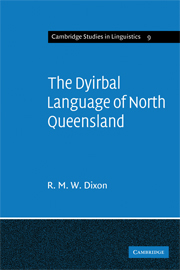Book contents
- Frontmatter
- Contents
- List of maps and plates
- Acknowledgements
- Preface
- Abbreviations and conventions
- 1 AUSTRALIAN LANGUAGES
- 2 DYIRBAL: THE LANGUAGE AND ITS SPEAKERS
- 3 WORD CLASSES
- 4 SYNTAX
- 5 DEEP SYNTAX
- 6 MORPHOLOGY
- 7 PHONOLOGY
- 8 SEMANTICS
- 9 LEXICON
- 10 PREHISTORY
- APPENDIX A DYIRBAL LOGIC
- APPENDIX B PREVIOUS WORK ON DYIRBAL
- TEXTS
- VOCABULARY
- LIST OF DYIRBAL AFFIXES
- REFERENCES
- INDEX OF AUSTRALIAN LANGUAGES
- Plate section
- Frontmatter
- Contents
- List of maps and plates
- Acknowledgements
- Preface
- Abbreviations and conventions
- 1 AUSTRALIAN LANGUAGES
- 2 DYIRBAL: THE LANGUAGE AND ITS SPEAKERS
- 3 WORD CLASSES
- 4 SYNTAX
- 5 DEEP SYNTAX
- 6 MORPHOLOGY
- 7 PHONOLOGY
- 8 SEMANTICS
- 9 LEXICON
- 10 PREHISTORY
- APPENDIX A DYIRBAL LOGIC
- APPENDIX B PREVIOUS WORK ON DYIRBAL
- TEXTS
- VOCABULARY
- LIST OF DYIRBAL AFFIXES
- REFERENCES
- INDEX OF AUSTRALIAN LANGUAGES
- Plate section
Summary
Chapters 3, 4 and 6 present the basic ‘facts’ of the grammar of Dyirbal. This chapter attempts to interpret, generalise from, and explain the basic facts; the discussion is thus at a higher level of abstraction, and is more speculative and arguable, than chapters 3, 4 and 6.
Points to be explained
In the last chapter we mentioned that certain types of sentence were possible but that other, similar types were impossible; that certain combinations of processes were acceptable while others were unacceptable; and that certain inflections which appeared to be rather different in function were identical in form. In no case did we attempt anything more than a limited and ad hoc explanation of these facts. Before we embark on an investigation of the underlying syntactic nature of Dyirbal, it will be useful to list some of the points from chapter 4 that appear to be in need of explanation:
[1] The fact that word order is quite free, except in the case of some particles, and when there is multiple embedding. It should be noted that it is the order of WORDS in sentences that is free, not just the order of phrases (4.5.4, 4.15.3, 7.8).
[2] The apparent conflict between the nominative-accusative paradigm of pronouns, and the nominative-ergative syntax of nouns, adjectives, and noun markers (3.2.1, 3.3.1, 4.1).
[3] Case inflections on pronouns – in particular, the difference between the inflections on singular pronouns in G, and in D and M (3.3.1).
[…]
- Type
- Chapter
- Information
- The Dyirbal Language of North Queensland , pp. 125 - 220Publisher: Cambridge University PressPrint publication year: 1972



